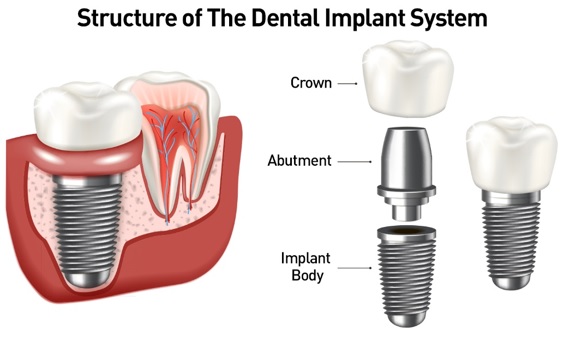Not known Facts About Dental Implants
Not known Facts About Dental Implants
Blog Article
More About Dental Implants
Table of ContentsFacts About Dental Implants RevealedDental Implants Things To Know Before You BuySome Ideas on Dental Implants You Need To KnowThe smart Trick of Dental Implants That Nobody is Discussing
are medical gadgets surgically dental implanted into the jaw to recover a person's capability to eat or their appearance. They supply assistance for fabricated (fake) teeth, such as crowns, bridges, or dentures. When a tooth is shed as a result of injury or illness, a person can experience issues such as fast bone loss, defective speech, or adjustments to chewing patterns that result in pain.
Framework of The Oral Implant System picking oral implants, talk to your oral copyright concerning the prospective benefits and dangers, and whether you are a candidate for the treatment. Things to consider: Your overall wellness is a vital consider establishing whether you are a great candidate for oral implants, for how long it will take to heal, and how much time the dental implant may stay in place.
Smoking cigarettes may affect the healing procedure and decrease the long-lasting success of the dental implant. The healing process for the implant body might take numerous months or longer, throughout which time you usually have a short-term joint instead of the tooth. the dental implant procedure: Carefully comply with the dental hygiene directions provided to you by your oral supplier.
Dental Implants - Truths
Implant failure can result in the need for another medical treatment to take care of or change the dental implant system. Brings back the capability to chew Brings back cosmetic appearance Helps keep the jawbone from shrinking due to bone loss Preserves the health of the surrounding bone and periodontals Assists keep nearby (neighboring) teeth secure Improves high quality of life Damages to bordering all-natural teeth throughout dental implant positioning Injury to the surrounding cells throughout surgical treatment, such as sinus perforation Injury throughout surgical procedure (for example, fracture of bordering jawbone) Inadequate function, such as feeling like the teeth do not bite with each other generally A sensation that the tooth is loose or twisting in position resulting from an abutment screw loosening Implant body failing (looseness of the implant body) due to systemic infection, which might be a lot more most likely in individuals with unrestrained diabetics issues as a result of neighborhood infection in bone and gums supporting the implant body due to delayed healing, which may be extra most likely in clients that smoke Problem cleaning the periodontals around the implant, causing bad dental hygiene Neglected periodontal condition Post-surgical pins and needles because of nerve impingement or damages Constantly notify wellness care suppliers and imaging technicians that you have oral implants prior to any kind of magnetic vibration imaging (MRI) or x-ray procedures.
FDA is not conscious of any type of damaging occasions reported for MRI or x-ray treatments with dental implants. Oral implants systems are typically constructed from products that comply with international agreement requirements of the International Organization for Standardization (ISO) or ASTM International. These requirements have information of what makes a secure product.
Various other materials such as gold alloys, cobalt-based alloys, titanium alloys, or ceramic materials are in some cases used. The safety and security profiles of these products are popular. Dental implant systems are evaluated according to international agreement criteria. Biocompatibility testing, to show that physical call with the device does not trigger difficulties like irritation or allergic reaction, is component of the examination that helps make sure the materials in the oral implant system are risk-free and do not trigger unfavorable results when implanted in individuals.

Getting The Dental Implants To Work
Some individuals are not qualified for oral implant surgery. click to find out more It is for oral cosmetic surgeons to operate people with: acute illnessuncontrollable metabolic diseasebone or soft cells condition or infectionIf these concerns are resolved, a person can have the surgery. Dental Implants. In, oral specialists abstain from operating on people with: If people with any of the above undergo oral implant surgical procedure, there is a greater threat of the implant failing
Some people have a jawbone irregularity that stops enough bone for an implant from establishing. In such situations, a doctor may require to carry out a ridge alteration. This involves lifting the gum to reveal the location of flawed bone. The specialist will certainly after that utilize a bone or bone alternative to fix and construct up the location.
Dental dental implant surgical treatment is an individualized process. Offer you time to heal. Attach the post and last crown, bridge or denture.
Next off, your cosmetic surgeon will thoroughly place the oral implant into your jaw. Your doctor will rearrange your gum tissues and shut the cut with stitches (Dental Implants). If your dental implant is near the front of your mouth, your dental practitioner will make a temporary tooth for you to use up until you recover. That way, you won't have a space in your smile while you recuperate.
Excitement About Dental Implants
Throughout the healing stage, your jawbone must fuse to the dental implant. This process can take anywhere from 3 to nine months.
As soon as your dental implant heals, your dental practitioner can attach the joint (little adapter article) and your last remediation (crown, bridge or denture). This typically takes concerning one hour to complete and may call for a second small surgical procedure. go to website You should not really feel any kind of pain throughout your oral implant procedure because your provider will certainly utilize drug to numb your periodontals.
Report this page